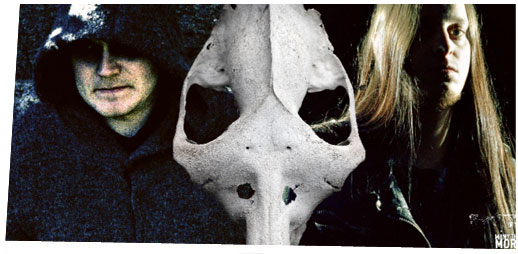
Darkthrone
- Story by Catherine Yates
How Darkthrone became Norwegian black metal’s first official career artists.
It’s not as if gravel-voiced singer and all around audio eccentric Tom Waits has ever found himself short of a few column inches, but you can imagine that even the old spooky tunester himself might be a little surprised to read of his kinship with Norwegian black metal.
“He’s the only really big artist I know who allows himself to have a ‘necro’ sound,” enthuses Darkthrone guitarist and vocalist Ted Skjellum (AKA “Nocturno Culto” if you want to keep things “true”) from a landline rooted somewhere in the mountainous wilds of Eastern Norway. “That’s the advantage of having a big studio at your disposal—Tom Waits has total control, and he chooses this crazy lo-fi sound to create an atmosphere for his albums. Just like we do.” The connection is less spurious than it might at first seem. Like Waits, the Scandinavian duo (completed by drummer Gylve “Fenriz” Nagell) have remained impervious to concerns of fame, success or trend. And while black metal’s notorious rise has seen ego and budget dilute the visions of their peers, the pair has spent the past fifteen years wilfully paring their brutal assaults down to ever more primitive manifestations.
They make no apology for it either: “We evolved first then decided to play primitive music again, who else did that?” elaborates Fenriz, via e-mail, his favored mode of communication. “Bands always soften. If Carcass still existed they’d be playing pop music now.” Darkthrone of course, haven’t softened. Sardonic Wrath—their latest album, is another superspeed maelstrom of treble-heavy nihilism that rubs squarely in the face of any notion that things mellow with age.
“In the early days we had a hatred towards many things, but I actually hate more today because my hatred is more calculated,” states the thoroughly informed and highly amenable Ted. “With age comes knowledge, and with knowledge comes more hatred.”
Few of their contemporaries have aged quite so well. Black metal was one of the last few genuine outposts of the extreme when it came to prominence in the late ‘80. Seeped in actual violence and bloodshed, the names Mayhem, Burzum, and Emperor became synonymous with murder, suicide and church burnings. The drummer’s recent compilation Fenriz Presents: The Best of Old School Black Metal provides a thrillingly visceral homage to such an era (“If I can get just one soul to understand the magic of Celtic Frost, it’s all worth it” he says). But with its leading lights either long dead, defunct or imprisoned you can’t help but wonder where exactly the “new school” of black metal resides in the face of such a violent legacy. Aside from Satyricon, whom Fenriz cites as the one “remarkable” evolution, few others in the scene have managed to combine musical integrity with longevity.
“It’s so different now,” says Ted. “The new school of black metal is like ‘circus metal’—bands trying to get attention. And when bands get too much attention, the music becomes less honest. With Darkthrone we’ve never allowed any pressure on us whatsoever. We are not out to earn money—we have jobs, we don’t tour, we don’t like attention and we play really hostile music.”
It’s a sentiment echoed by the launch of their new label Tyrant Syndicate Productions, which has seen the band renew ties with their former label Peaceville (Sardonic Wrath is their last release for Satyr’s Moonfog imprint, although the pair insist the parting is amicable—the chance to have their own label being too good an opportunity to pass up).
“Our only goal is to present music from the underground, because it’s the most honest,” he explains. “People are playing exactly what is on their mind.” One such example is Aura Noir whose The Merciless album is the first release on the label and whose brutally proficient machinations can also be heard on Fenriz Presents…
“Everyone who claims they like metal should like them,” says Ted. “For us it’s a privilege to release it because it’s a great album and I think they’ve been fucked over by every label they’ve had before.”
Still, Darkthrone may not be able to avoid the spotlight of publicity themselves with their next album (the “difficult 13th” jokes Fenriz), which will see their spiky logo surrendering itself to the hands of New York artist Banks Violette. Violette has long cited the Norwegian black metal scene—and Darkthrone in particular—as major influences on his Giger-esque sculptures and paintings. His last installation was inspired by the three metal teens from Arroyo Grande, California who killed a classmate to promote their band Hatred.
Neither Fenriz nor Ted were aware of this, they say, but it’s unlikely to stop comparisons being drawn with black metal’s bloodstained roots in the name of sensation. Are they happy still being associated with such negative examples of human behavior?
“It’s just kids trying to take a short cut to fame,” says Fenriz. “I’ve always hated that. Even back in the ‘80s when a band had a card out before they had a demo or shirts after the third rehearsal. It’s like, fuck off and die.”
Skjellum offers a less blunt perspective. “For me, it’s sickening that bands would do something like that to get attention, but I’ve met a lot of metal people and my conclusions are more positive. There’s a lot of decent people out there with brains, and on the whole, it’s heartening to see the level of intelligence that’s in the scene.” He considers, “I mean people are always doing stupid things, but come on, the human race is full of stupid people.
“After all,” he concludes, with what is surely a fitting epithet for Varg Vikernes’ cell, “There’s a big difference between being a visionary in music and being a criminal.”

